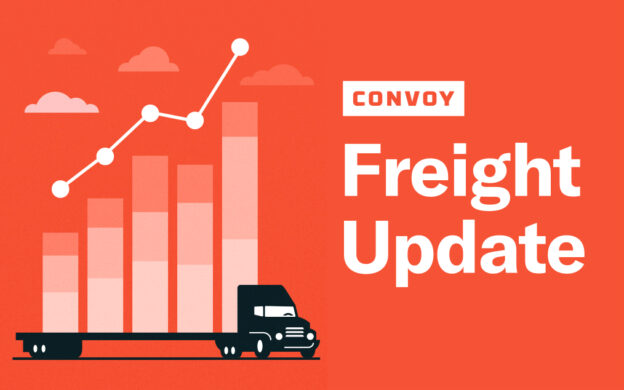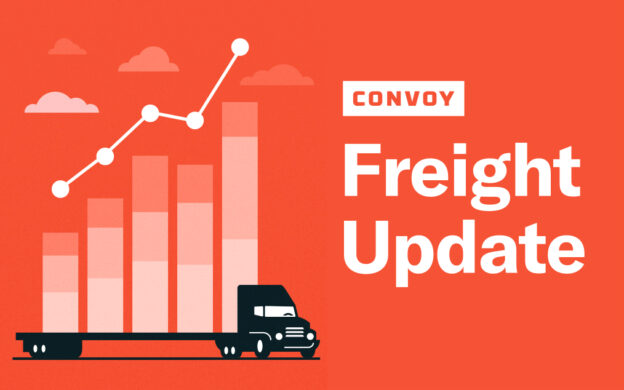Coronavirus and Freight: Market Outlook Video (March 24, 2020)
Freight Research • Published on March 24, 2020
There’s no shortage of media coverage about COVID-19’s broad impacts. We hear from our shippers and from the carriers in our network that there’s an appetite for analysis on what the current coronavirus outbreak means for supply chains and for the freight industry from the perspective of a Digital Freight Network.
That’s why today we’re launching a twice weekly video series featuring Ari Bixhorn, our Head of Shipper Marketing and Aaron Terrazas, our Director of Economic Research. You can view the first video here:
Every Tuesday and Thursday we will publish a new video in which we’ll cover:
- Analysis to help you understand what’s happening in the freight industry
- Important stories beyond the headlines
- Movements we’re seeing on Convoy’s Digital Freight Network
- Trends that shippers and carriers should pay attention to in the days ahead
Making these insights available directly to you is part of Convoy’s commitment to promoting transparency across the freight industry and providing insights into the supply chain, so that everyone can make more informed business decisions in these uncertain and volatile times. Our previous analysis can be found on Convoy’s blog here.
Subscribe to Freight Economics Updates to get the latest developments delivered directly to your inbox.
Convoy provides shippers reliable, flexible, and instant capacity when they need it most. Learn more about shipping with Convoy today.
View our economic commentary disclaimer here.

You can read the a transcript of the conversation below:
Ari Bixhorn: Hey everyone, I’m Ari Bixhorn from the Convoy team and today I’m joined by Aaron Terrazas, our director of economic research. Aaron, welcome.
Aaron Terrazas: Hi Ari.
Ari Bixhorn: This is the first installment of a new video series that we’re doing to bring you the latest information and analysis on our freight market given the ongoing impacts related to COVID-19. Today we are coming at you from Seattle where we’re both practicing social distancing and having a discussion over Zoom. This is being recorded on the evening of Monday, March 23rd. So without anything further, let’s go ahead and dive in.
Aaron, you know the current pandemic is affecting people all around the world and just this morning our US Surgeon General said and I quote, “This week, it’s going to get bad in North America.” Now, there’s no shortage of news about the impact that coronavirus has been having on all of our lives, but what we’ve heard from our audience is that they’d like a deeper analysis on how things have been impacting the freight industry. So based on that, what are the things that are absolutely essential to understand in terms of what’s happening with trucking?
Aaron Terrazas: Sure. Freight has certainly been in the spotlight and supply chains have been in the spotlight over the past two weeks. They are very much on the front lines of responding to this national crisis as consumers have prepared to shelter in place and they’ve stocked up on goods and cleaning supplies and food and that has emptied shelves around the country. We are certainly seeing this throughout our network. There’s been a surge anywhere from six to tenfold in the most affected markets.
That said, there are really two sides to what’s happening here. On the one hand there has been the surge in demand for household staples, for food and beverage, for all of those packaged goods that consumers are stocking up on.On the other hand, as increasingly broad sectors of the American economy shutdown, that is a net loss in freight demand. We know that non-discretionary retail — things like apparel, recreation — all of those sectors, like restaurants are shut down. That means they’re no longer needing inbound freight shipments. So it is a rare moment of volatility and uncertainty for the nation’s economy, as well as for the nation’s freight market. This is an unprecedented moment. And, I think more than ever there are questions about what happens to supply chains over the coming weeks.
Ari Bixhorn: Yeah. You mentioned consumer goods and there have obviously been a lot of stories recently about people hoarding toilet paper and hand sanitizer. I guess, what are the stories that are being overlooked? What are the trends that we’re seeing within our own freight network?
Aaron Terrazas: No, certainly you’re right. There are those headline stories of the types of goods that consumers are buying. I think, in the background of everything that has happened and how consumers are feeling throughout these portions of the American economy continue to hum along. Certainly not at their normal pace, but for instance, you take the seasonal kind of inbound fruit and produce from Northern Mexico, which usually starts to increase around this time of year. It comes across the Texas border. We’re seeing that surge and demand. Meanwhile, a lot of truckers have repositioned themselves to service those urban consumers that have kind of seen this enormous demand for those household goods. There’s a lot of fruit and vegetables waiting to be moved across the border at the same time.
Another angle, I think, that’s not necessarily being discussed is what is happening in oil markets.It used to be the case that any time oil prices declined, that was generally a good thing for American consumers because that meant consumers had more money in their pockets. They were spending less money on gas. This time with so many people staying home, not commuting to work, not driving around, perhaps there’s less of a positive impact to their potential for spending then there would have been in another area, another time. So kind of different currents perhaps that are getting lost in the background of the headlines.
Ari Bixhorn: In terms of the headlines, we’re seeing things evolve on a day-to-day basis. Going into next week, what are some of the things that you’re going to be paying attention to and what should our shippers be keeping their eyes on?
Aaron Terrazas: I think there are three things that are top of mind coming into this week.
First, obviously what’s happening in Washington, our nation’s Capital. In order to keep the long term damage from this period to a minimum, it really is important that households that are having their budgets stretched, that aren’t getting a regular paycheck, are able to continue to buy food and continue to pay their rent and maintain their health coverage. If those consumers are able to continue spending, certainly the types of things that they spend their money on is going to shift. They’re going to be buying more groceries and less restaurants. More cleaning supplies and less clothes, but they’re going to be able to continue spending and consumer spending is at the end of the day, what drives the American economy.
The second thing that I’m watching is the same thing that everyone in financial markets and public health officials and public officials around the country are watching and that’s the number of new infections.It’s really at this point all about that curve, bending that curve and once we get a sense of the number of new infections begins to decelerate, I think people are going to start feeling more confident, more comfortable in the future.
The third set of metrics that I’m looking at are our incoming data. You think of unemployment insurance claims. We should get those Thursday morning for this past week. That’ll really give us one of our first quantitative looks at how deep the cuts have been across the American labor market. How many people have lost their jobs, how many people are starting to feel really worried about their future. And in the same sense, consumer sentiment for March will be published on Friday. That’s going to give us a sense of the scale of anxiety consumers are feeling,
Ari Bixhorn: We’re obviously very early days here, but do you have any sense as to the long-term impacts of the current crisis?
Aaron Terrazas: Obviously, these are still very, very early days. Some of the shifts that I expect will come out of this are things that were already in the works. You think of the diversification of supply chains. That is something that began with the trade war and this will certainly accelerate and come into greater focus. But increasingly producers and manufacturers are recognizing the risk of concentrated supply chains, and distribution networks, and are looking to build robot robustness into their supply chains.
I think that one of the second lessons I take away that I think will stick from this period is how important it is to build automatic processes into these systems that are so vital to our lives. You look at the systems that have proven to be most robust to these disruptions, those are the systems that are able to scale quickly, that are automated where the potential risk from, parts of the country or teams going offline is pretty minimal.
There are also questions about consumer preferences. How will savings and consumption patterns shift after this? You think about every previous crisis in the American economy: After the oil crisis of the 1970s, after the dotcom bust of the early 2000s, after black Monday in the 1980s, after the financial bust in 2008, consumers have shifted their preferences on the margins.They decide to save or spend a little differently after each one of these periods. The younger generations in particular have these formative memories of these periods and our vow kind of to learn from those mistakes.
It’s also at the same time easy to overstate their impact. As this is, ultimately, a rare event and you don’t build your whole supply chain around rare events, you build them to be robust to those rare events but I think many things will continue to be the same once this period resolves itself, as well.
Ari Bixhorn: I think one of the things that the crisis has shown us is just the critical role that the freight industry and the supply chain industry plays in our broader economy.
Aaron Terrazas: Certainly.
Ari Bixhorn: So on behalf of Convoy, I wanted to thank all of the shippers, carriers, drivers, and really everyone out there who’s working tirelessly around the clock to deliver the supplies that people need most urgently. Aaron and I are going to be back. We’ll provide regular updates on coronavirus and the freight industry. Please subscribe to our YouTube channel and the Convoy blog to stay informed. Aaron, thanks again.
Aaron Terrazas: Thank you Ari


